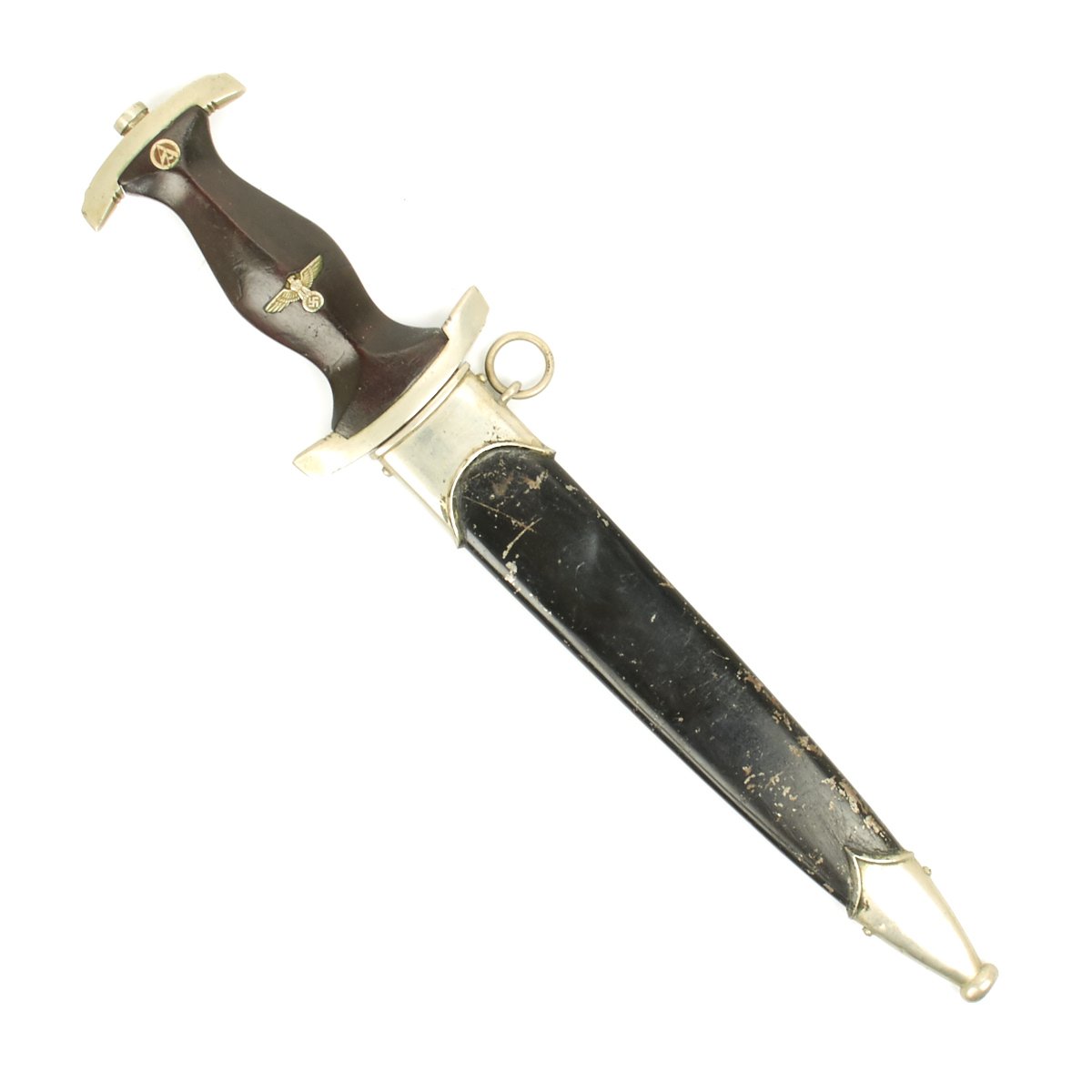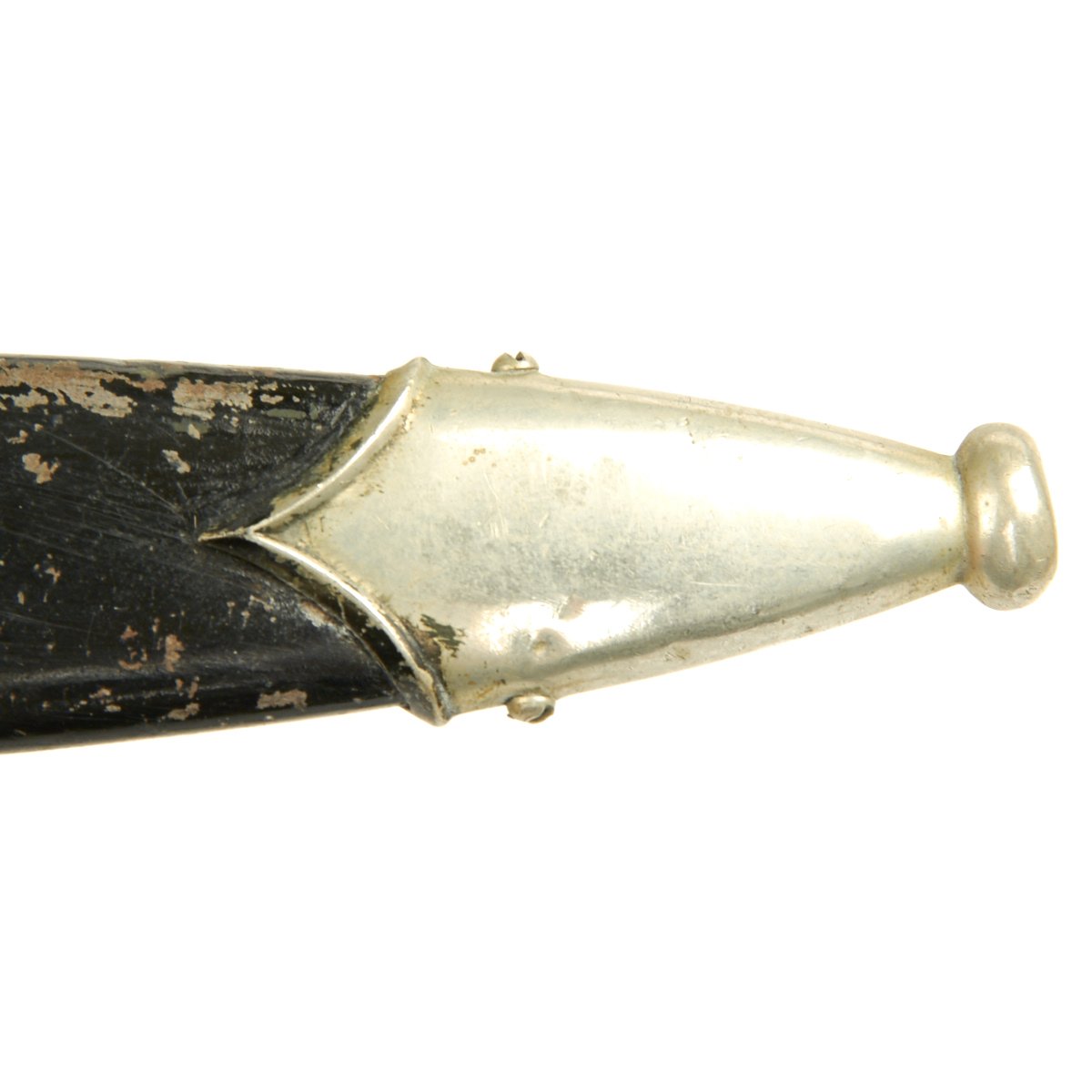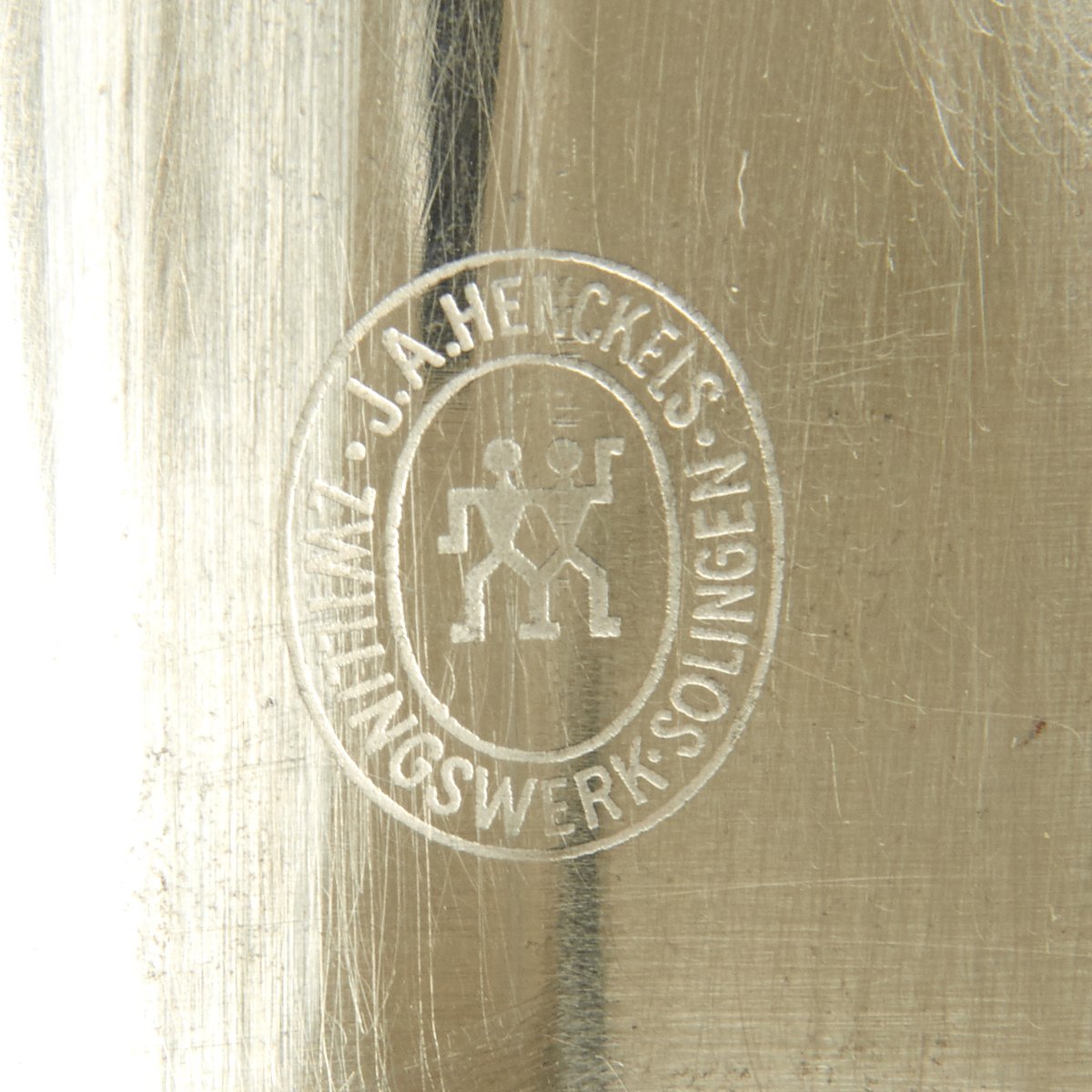Original German Pre-WWII Early NSKK Enlisted Man’s Dagger by J.A. Henckels – Pre 1935 Original Items
$ 995,00 $ 248,75
Original Item: Only One Available: This Early production NSKK EM Dagger is an excellent example, and was made by the Solingen-based company J.A. Henckels. The crossguards and other fittings are solid nickel alloy, and in good condition. There are a few dents in the cross guards, showing they are not plated, and the scabbard fittings are non-magnetic, which means they are definitely nickel.The surfaces on the guards are smooth with good crisp edges and precise accent grooves. The tang nut matches nicely and does not appear to have been out in modern times. Also, the lower reverse guard is Gruppe stamped “Wf”, for Westfalen. This feature was only seen on daggers produced 1935 and prior.
The grip is a fine fruit wood, dark brown in color and with a vertical grain and clear center ridge. The SA symbol button is perfectly placed and the enamel and plating are in good shape. The nickel grip eagle is clean and crisp. The bird retains full detail through the breast and wing feathering, talons and wreathed mobile swas. The grip fits the guards like a glove and is in very good condition with just a bit of cracking and a ship near the lower guard.
The scabbard is straight throughout. It has a nice black paint job that was done after the NSKK order to paint the shells to differentiate themselves from the rest of the SA. The scabbard mounts are in good condition through to the lower ball which shows usage and an indentation, typical of the softer nickel alloy. All of the screws are in place.
The blade of this dagger is in very good condition, bright and having a good amount of the original grain from the final factory polish. There are some in and out marks, and some signs that it was polished a bit. The motto is deep and crisp, with a fine frosted background. The blade shoulders perfectly meet the crossguard contour.
The reverse of the blade is marked with the maker J.A. HENCKELS – ZWILLINGSWERK – SOLINGEN. This is in a circle around the company’s “twins” (Zwilling) trademark logo, in use since the company founding in 1731. This is a well known maker, with somewhat lower production, so these are definitely harder to come by. They were based in the legendary “City of Blades”, Solingen, where much of the German edged weapon industry was based for centuries, continuing to present day.
History of the SA-
The SA or Brown Shirts, were a private political formation which Adolf AH and the NSDAP used to maintain order at organized Party meetings and demonstrations. The group was formed in 1921, and grew to a huge force of nearly 3,000,000 men by the later 1930’s. To instill esprit de corps, as well as create employment for the Blade City of Solingen, it was decided each SA man would carry a dagger with his Brown Shirt uniform. Huge quantities needed to be produced to accommodate the demand. The dagger initially was produced of hand-fitted nickel mounts with attractive finished wood grip and brown anodized (a bluing process) finished scabbard.
The blade was etched with the SA motto, Alles für Deutschland. Examples produced prior to 1935 were stamped with the German sector of the SA group on reverse lower crossguard. Later examples underwent standardization through the RZM ministry. These pieces were produced of cheaper plated zinc-base fittings and scabbards were simply painted brown.
Prior to his “unmasking” as a traitor, Ernst Röhm was the leader of the SA. In 1934, he distributed approximately 100,000 SA daggers with his personal inscription on the reverse blade. These daggers were to honor individuals who had served with the SA prior to December, 1931. Other than the inscription, these pieces were identical to the standard M1933 SA dagger. After the Röhm purge, the inscription was ordered to be removed. Many examples were returned to the factory for grinding. Others were simply ground in the field by whatever means were available. Examples will occasionally be encountered with remnants of the original inscription remaining on the blade, but mostly none will remain. Some blades exist with an intact inscription, reflecting only the removal of the Röhm signature. Very very rarely is an example seen with a full, untouched inscription, as the holder would have surely risked a charge of treason.
Fast Shipping with Professional Packaging
Thanks to our longstanding association with UPS FedEx DHL, and other major international carriers, we are able to provide a range of shipping options. Our warehouse staff is expertly trained and will wrap your products according to our exact and precise specifications. Prior to shipping, your goods will be thoroughly examined and securely secured. We ship to thousands clients each day across multiple countries. This shows how we're dedicated to be the largest retailer on the internet. Warehouses and distribution centres can be located throughout Europe as well as the USA.
Note: Orders with more than one item will be assigned a processing date depending on the item.
Before shipping before shipping, we'll conduct a thorough inspection of the items you have ordered. Today, the majority of orders will be delivered within 48 hours. The delivery time will be between 3-7 days.
Returns
The stock is dynamic and we cannot completely manage it because multiple stakeholders are involved, including our factory and warehouse. So the actual stock may alter at any time. It's possible that you may not receive your order once the order has been made.
Our policy is valid for a period of 30 days. If you don't receive the product within 30 days, we are not able to issue a refund or an exchange.
You can only return an item if it is unused and in the same state as the day you received it. You must have the item in its original packaging.
Related products
Uncategorized
Uncategorized
Uncategorized
Uncategorized
Australian WWII Owen MK1 Machine Carbine SMG Custom Fabricated Replica with Sling Original Items
Uncategorized
Uncategorized
Armoured Fighting Vehicles of the World: AFVs of World War One (Hardcover Book) New Made Items
Uncategorized
Uncategorized
Armored Burgonet Helmet & Polearm from Scottish Castle Leith Hall Circa 1700 Original Items
Uncategorized
Uncategorized
Uncategorized
Uncategorized
Uncategorized
Angolan Rebel 1970s era 60mm Inert Display Mortar from Angolan Civil War Original Items
Uncategorized
Uncategorized
Uncategorized
Uncategorized
Uncategorized












































































